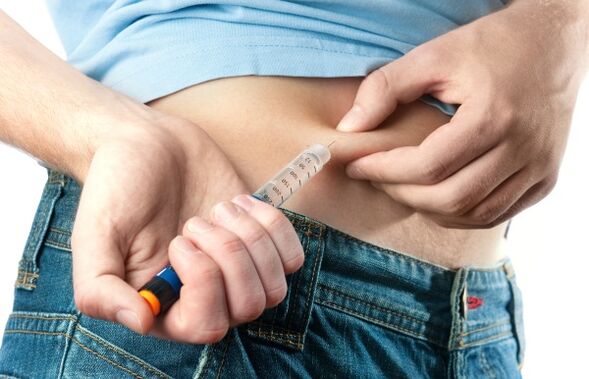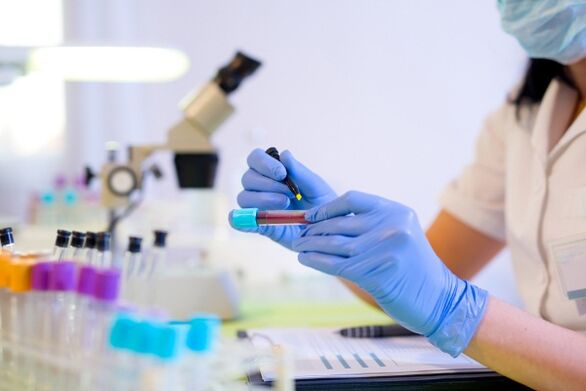Diabetes mellitus is accompanied by an inability to absorb glucose, which leads to its accumulation in the blood. Type 2 disease is milder than type 1 disease. The basis for treating the disease is diet and medication.
Type 2 diabetes – characteristics of the disease
For normal functioning, the body requires a constant supply of energy, which is obtained from the food consumed. The main supplier is glucose. To absorb sugar into tissues, a hormone is needed - insulin, which is produced by the pancreas.
In type 2 diabetes, the gland functions normally, but the cells develop resistance to the hormone. As a result, sugar is not released into the cells but remains in the blood plasma. The body begins to lack energy. The brain reacts to the situation with a signal to increase insulin production.An increased concentration of the hormone does not change the situation.
Gradually, due to wear and tear on the organ and depletion of reserves, insulin production decreases significantly and may even stop altogether. The disease develops gradually and initially does not have any pronounced symptoms. In an advanced form of the disease, stage 1 can occur.
Reasons for development
Type 2 diabetes often occurs as a result of wear and tear on the body, so the pathology occurs more often in people over 40 years old.
But there are other reasons and provoking factors for the development of the disease:
- Transmission at the genetic level. If you have relatives with diabetes (of any type), the likelihood of developing the pathology increases by 50%;
- Obese people are more prone to developing the disease, as fat deposits reduce the sensitivity of cells and also impair the functioning of organs.
- incorrectly composed diet. Frequent consumption of sweet, fatty and quickly digestible foods;
- low consumption of energy reserves, occurs with low physical activity;
- pathological changes in the pancreas;
- common infectious diseases that affect the functioning of the digestive tract;
- nervous and physical exhaustion as well as frequent stress and depression;
- frequent increase in blood pressure;
- Violation of medication intake with the development of side effects that affect the functioning of the gland.
A pathology arises when two or three causes exist at the same time. Sometimes the disease is diagnosed in pregnant women. In this case, its occurrence is associated with hormonal changes in the body. The disease (usually) goes away on its own after delivery.
What happens when you have diabetes?
Diabetes mellitus type 2 (diet and drug treatment are related: without diet, taking medication is ineffective) affects the functioning of the entire body. As the disease begins to develop, tissue sensitivity to insulin decreases. The pancreas and other organs function normally.
Without appropriate treatment, the glucose concentration in the blood increases, which leads to "saccharification" of the protein cells in the blood. This change disrupts the functioning of the organs. The body suffers from a lack of energy, which also leads to malfunction of all systems.
The lack of energy is compensated for by the breakdown of fat cells. The process is accompanied by the release of toxins that poison the entire body and impair the performance of brain cells.
Excess sugar leads to dehydration; useful vitamins and minerals are washed out with water. The condition of the blood vessels worsens, leading to cardiac dysfunction. The risk of vascular blockage due to blood clots also increases. This affects vision, liver and kidney function as these organs contain many small blood vessels. Blood circulation in the extremities is impaired.
Symptoms of type 2 diabetes
In the early stages the disease progresses without any visible symptoms. If the disease is not recognized or adequate treatment is not provided, the pathology continues to developaccompanied by characteristic symptoms:
- a constant feeling of dryness in the mouth, accompanied by unquenchable thirst. This symptom occurs because a large amount of fluid is needed to remove excess glucose from the blood. To do this, the body uses all the fluid and water flowing in from the tissue;
- the formation of a large amount of urine, causing the person to go to the toilet frequently;
- increased sweating, which increases during sleep;
- increased dryness of the skin and mucous membranes, accompanied by itching;
- Lack of moisture and poor nutrition of the optic nerve lead to impaired vision;
- Microcracks and wounds heal more slowly;
- arbitrary twitching of muscle tissue occurs due to a malfunction of the nervous system;
- swelling of the limbs, accompanied by pain and numbness;
- due to lack of energy, severe weakness, increased appetite and cardiac arrhythmias are felt;
- a sharp decrease in immunity, which causes frequent colds.
In the early stages there is increased appetite, fatigue and a frequent need for fluids. To rule out/confirm diabetes, you must contact your family doctor/pediatrician for a blood glucose test. At the beginning of the disease, it is enough to adjust the diet for treatment.
stages
Depending on the severity of symptoms, treatment features and complications related to the disease, diabetes is divided into 4 levels of severity.
| Degrees of pathology | Key Features | Distinctive features |
|---|---|---|
| Light | The disease occurs with a slight increase in blood sugar concentration, resulting in increased thirst, appetite and muscle weakness. There are no pathological changes in body function. Dietary changes are used as therapy. In rare cases, medication is prescribed. | In rare cases, diabetes is diagnosed at this stage, especially during medical examinations as part of a blood test. The composition of urine does not change. The glucose level is in the range of 6-7 mmol/l. |
| Average | The symptoms of the disease are increasing. There is a deterioration in the function of the visual organs and blood vessels, and the blood supply to the extremities is disrupted. There are no serious dysfunctions of the body. Treatment is with diet and medication. | The sugar content in the urine is normal, in the blood it is 7-10 mmol/l. |
| Difficult | The symptoms are pronounced. There is a severe dysfunction of the organs (decreased vision, constantly increased blood pressure, pain and tremor of the extremities). Treatment occurs according to a strict menu and insulin administration (drug therapy does not produce results). | Elevated sugar levels are detected in urine and blood. The concentration in the blood fluctuates in the range of 11-14 mmol/l. |
| Increased severity | Organ dysfunction is practically irreversible. The disease cannot be treated; constant monitoring of sugar and its regulation through insulin injections is required. | The glucose concentration remains in the range of 15-25 mmol/L. A person often falls into a diabetic coma. |

Mild to moderate diabetes is easy to treat and control blood sugar. In these stages there is no significant disruption to body functions. Complete recovery can sometimes be achieved through diet, weight loss, and medication.
diagnosis
Type 2 diabetes mellitus (diet and treatment are prescribed after diagnosis) is determined by laboratory methods. Additionally, a hardware examination is performed to detect the development of complications. First, a specialist examines the patient and finds out when the first symptoms of the pathology were discovered.
Investigation methods:
- Donate blood on an empty stomach. The glucose concentration is determined without the influence of food.
- Determination of the amount of sugar after eating or taking medications containing glucose.
- The dynamics of the rise and fall of sugar throughout the day is checked. Necessary to determine the correctness of the prescribed treatment.
- Urine release to determine its composition (sugar, protein, acetone). As well as the detection of kidney dysfunction.
- A detailed blood test to detect a malfunction in the gastrointestinal tract.
- Additional hardware investigations:
- Ultrasonic;
- ECG;
- Dopplerography;
- Capillaroscopy.

A complete examination allows you to determine the severity of the disease and its impact on organ function. If abnormalities are discovered, the patient is treated by several specialists, depending on which organs were damaged.
Diagnostics is also necessary for people who are at risk of developing the disease (heredity, obesity, age over 45 years).
Treatment of type 2 diabetes mellitus
Pathology therapy consists of complex treatment. Depending on the severity of the disease, the specialist will prescribe medication, create a menu and prescribe physical exercises to lose weight.
Antihyperglycemic medications
Type 2 diabetes is initially treated with diet.If the treatment does not have a visible effect, the specialist prescribes medications that lower blood sugar levels. At the beginning of treatment, 1 type of medication is prescribed. To ensure the effectiveness of treatment, the number of medications is gradually increased.
Types of blood sugar-lowering medications and their effects:
| Type of medication | Your purpose |
|---|---|
| Glinides and sulfonylurea derivatives | Prescribed to increase the body's production of insulin. |
| Biguanides and glitazones | Reduces glucose production in the liver and increases tissue sensitivity to sugar. Helps reduce appetite. |
| Alpha-glucosidase inhibitors | Reduce the rate of glucose absorption by intestinal tissue. |
| Gliptins and glucagon-like peptide receptor agonists | They increase insulin production and at the same time reduce sugar concentrations. |
| insulin | Promotes the absorption of glucose by body tissues. |
| Thiazolidone derivatives | Increases the sensitivity of cell receptors to insulin. |
Most often, 2 or 3 drugs that are compatible with each other are prescribed. By simultaneously taking drugs that increase insulin production and drugs that affect the sensitivity of cells to the hormone, you can achieve an effective reduction in blood sugar.
It is dangerous to choose medications yourself. A sharp drop in sugar concentration also has a detrimental effect on the functioning of the body. If the drug causes side effects, it is replaced by a therapist. If medications are ineffective, the patient is switched to insulin therapy.
Insulin therapy
Insulin is prescribed as therapy when the production of the hormone by the pancreas is reduced. The dose and number of injections depend on the type of diet prescribed and the level of physical activity. An obese patient with diabetes is prescribed a low-carbohydrate diet, which requires more frequent monitoring of glucose concentrations.
The use of injections allows you to maintain the functionality of the pancreas (the organ does not wear out from increased loads). It also reduces the likelihood of complications.
In addition, the use of injections allows:
- normalize the amount of sugar in the blood during the day;
- improve the production of the hormone by the gland independently, in response to an increase in glucose concentration after eating;
- reduce the formation of glucose from non-carbohydrate compounds;
- Control of glucose production in the liver;
- normalize the production of lipids and glucagon.
The injections are painless and are administered using a special syringe with markings to control the amount of medication. Sugar levels will be measured before and after the procedure.
Diet for type 2 diabetes. Principles of Nutrition
In the treatment of diabetes, constant adherence to a diet is required, which depends on the severity of the disease, the presence of excess weight and physical activity. The menu must be coordinated with the treating specialist. If the amount of sugar changes (increase or decrease), the therapist changes the diet.
When adhering to a diet, important conditions must be observed:
- Eating should occur at specific times at least six times a day.
- the food should not be high in calories and easy to digest;
- If you are overweight, you need to reduce the calorie content of your meals;
- the amount of salt consumed should be kept to a minimum;
- Alcohol and fast food snacks are excluded;
- high fruit content and taking vitamin supplements to maintain immunity.
It is advisable to prepare dishes without or with a minimal amount of oil (you can boil or bake). It is necessary to increase the amount of clean water consumed per day. When drawing up a menu, be sure to take into account the presence of other pathologies (diseases of the gastrointestinal tract, heart, kidneys).
Prohibited products
Diabetes mellitus type 2 (diet and treatment lead to a positive result with proper nutrition) in a mild form can be eliminated by eliminating harmful dishes and foods from the diet.
| Strictly prohibited products | Conditionally prohibited products |
|---|---|
|
|
The amount of consumption of conditionally prohibited products must be agreed with the treating specialist. They increase the amount of glucose, but gradually. It is forbidden to consume two or more types of products from the list of conditionally prohibited products at the same time.
How do you monitor blood sugar levels if you have diabetes?
Diabetes requires regular monitoring of sugar levels.To measure it at home, a blood glucose meter is used.It is mandatory to take measurements daily in the morning before eating. If possible, measure throughout the day (after eating, vigorous physical activity).
All data must be recorded in a special notebook, which must be presented to the therapist at the next examination. Therapy (medications, diet) is adapted to the dynamics of glucose changes. In addition, you will need to have a laboratory test every 3-6 months (as determined by your doctor).
List of approved products with indication of the GI
If you suffer from diabetes, you are allowed to eat the following foods in any quantity, but taking into account their calorie content and GI.
| Shopping List | GI (glycemic index) |
|---|---|
| Boiled eggs | 48 |
| Boiled mushrooms | 15 |
| sea kale | 22 |
| Boiled crabs | 5 |
| kefir | 35 |
| Soy milk | thirty |
| cottage cheese | 45 |
| Tofu cheese | 15 |
| Low-fat milk | thirty |
| broccoli | 10 |
| Cucumbers | 10 |
| tomato | 20 |
| aubergine | 20 |
| Olives | 15 |
| radish | 10 |
| Apples | thirty |
| Pear | 34 |
| plum | 22 |
| cherry | 22 |
| Bread made from rye flour | 45 |
| dill | 15 |
| salad | 10 |
| Pearl barley porridge on water | 22 |
| Whole wheat pasta | 38 |
| oatmeal | 40 |
| Bread | 45 |
| jam | thirty |
This list can be expanded by the therapist taking into account physical activity and the severity of the disease.
home remedies
Type 2 diabetes mellitus (diet and treatment are necessary conditions to prevent the development of complications and further development of the disease) can be additionally controlled using folk remedies. It is recommended to discuss use with your doctor.
Recipes that normalize metabolism in the body and promote weight loss:
- Stir 70 ml honey and 40 g dry cinnamon (powder) into 0. 4 liters of boiling water. Leave in the cold overnight. The drink is divided into 2 portions. Use morning and evening. The duration of therapy is up to 14 days.
- Steam 10-12 pieces in 0. 5 liters of water. Bay leaves. Use 30 ml three times. Course 10 days. It is necessary to conduct 3 courses with breaks of 10 days.
- Steam linden blossoms instead of tea leaves. Drink up to 2 cups of tea per day.
- Finely chop 350 g garlic and parsley and 100 g lemon peel. Stir and let sit in the cold for up to 14 days. Take 10-12 mg per day.
- Boil 20 g of beans in 1 liter of water (4 hours). Consume up to 300 ml per day (can be divided into portions). The duration of therapy is 31 days.
- Drinks prepared instead of tea (consume 400 ml per day) from:
- herbs St. John's wort, chamomile, blueberry;
- aspen bark;
- bean wings;
- whole cinnamon.

If there is an intolerance or an allergic reaction, drinks are excluded from the menu.
Physical movement
Physical warm-up exercises must be performed even if there are no weight problems. Exercises allow you to normalize the functioning of the heart, blood vessels and respiratory organs and stabilize the general condition of the entire body.
When training, it is important to correctly consider the load, since increased calorie burning quickly leads to hunger, and food after training can be digested with a large release of glucose into the blood.
Recommended sports for diabetes:
- exercises with dumbbells;
- walks in the park or light jogging;
- Ride a bike;
- Bathe;
- Yoga;
- quiet dancing.

It is advisable to discuss the type of teaching with your treating specialist. In addition, the necessary time is spent on the procedure.
Complications of the disease
If the disease is detected in an advanced stage, inadequate treatment has been carried out orIf the patient does not follow the specialist's recommendations, dangerous complications may occur:
- Swelling.Edema can occur not only outside (arms, legs, face), but also inside the body. Depending on what caused the symptom to develop. This can be the development of heart or kidney failure, which also develops as a complication of diabetes.
- Pain in the legs.The symptom initially appears during intense physical activity. As the disease progresses, pain also occurs at night. In addition, there is numbness in the limbs and temporary loss of sensation. A burning sensation may occur.
- The appearance of ulcers.Due to the increased sugar content, wounds heal poorly and take a long time, which leads to the development of open ulcers. The therapist recommends treating even small cuts carefully until the wound has completely healed.
- Development of gangrene. With diabetes, the condition of the blood vessels is disturbed, which can lead to their blockage. This phenomenon is most often observed on the extremities. Due to the formation of a blood clot, fresh blood with oxygen and nutrients does not reach the hand/foot. Tissue death occurs. Initially there is redness, accompanied by pain and swelling. If no treatment is given, it will eventually turn blue. The limb is amputated.
- Pressure increase/decrease.Changes in blood pressure often occur due to kidney dysfunction.
- Coma.This condition can occur with a sharp increase or decrease in glucose concentration (due to an overdose of insulin). Or through severe poisoning of the body with toxins that are produced when fat cells produce energy. At the same time, the patient becomes covered with cold and sticky sweat, speech becomes slurred, and he becomes unconscious. When glucose increases, an odor characteristic of acetone appears. Next comes unconsciousness. Without help, a quick death is possible.
- visual impairment. Due to poor nutrition of the eye tissue and nerves. At first spots and a haze appear, and gradually complete blindness can occur.
- Impaired kidney function.Due to the heavy strain on the organ, kidney failure occurs.
By treating diabetes, consequences can be avoided. Timely detection of the occurrence of complications prevents their further progression.
Clinical guidelines for type 2 diabetes
If diabetes is diagnosed, an urgent visit to the doctor and a sugar test is necessary. If the disease is confirmed, you must undergo a full examination. Next, you need to follow all the recommendations of the treating specialist (diet, medications, exercises). Be sure to check your blood sugar concentration. If the condition changes, the treating doctor must adjust the treatment.
Diabetes mellitus can develop gradually and be detected in the middle stages. For type 2, diet is the basis of treatment. In advanced cases, medication or insulin injections are required.













































































